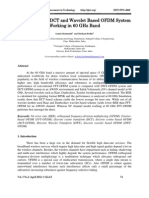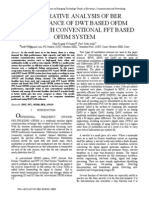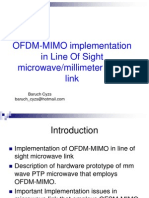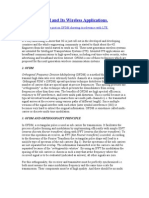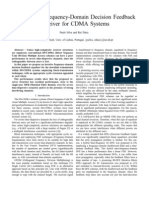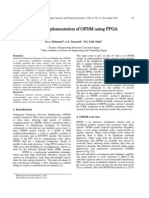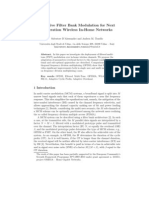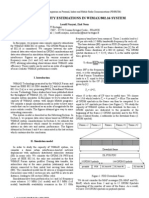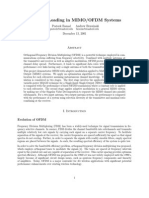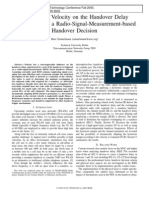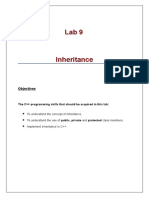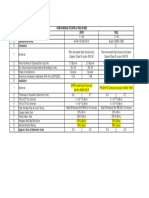Reduced Complexity Decision Feedback Equalizer For Supporting High Mobility in Wimax
Reduced Complexity Decision Feedback Equalizer For Supporting High Mobility in Wimax
Uploaded by
joy0302Copyright:
Available Formats
Reduced Complexity Decision Feedback Equalizer For Supporting High Mobility in Wimax
Reduced Complexity Decision Feedback Equalizer For Supporting High Mobility in Wimax
Uploaded by
joy0302Original Title
Copyright
Available Formats
Share this document
Did you find this document useful?
Is this content inappropriate?
Copyright:
Available Formats
Reduced Complexity Decision Feedback Equalizer For Supporting High Mobility in Wimax
Reduced Complexity Decision Feedback Equalizer For Supporting High Mobility in Wimax
Uploaded by
joy0302Copyright:
Available Formats
Reduced Complexity Decision Feedback Equalizer for Supporting High Mobility in Wimax
Iulia Ivan, Bertrand Muquet
Sequans Communications, 19 Le Parvis, 92073 Paris La Dfense, France
AbstractIn this paper, we consider the performance of Wimax systems in fast varying environments. While optimal in static channels, we first show that the conventional single tap OFDM equalizer is not satisfying even at moderate terminal speeds of 60km/h. We then study the performance of linear sliding window equalizers in the Wimax context before focusing on decision feedback equalizers (DFE). Based on our analysis, we propose a new DFE equalizer using sliding window that offers a good trade off between performance and complexity. Index TermsWimax, 802.16e, equalization, intercarrier interference, OFDM, OFDMA, time-varying channels, DFE, sliding window
factorization, but this technique still requires inverting the entire matrix. Recently, several interesting structures based on sliding window equalizers have been proposed. The decision feedback equalizer (DFE) proposed in [5] yields very good performance but at the price of inversion of large matrices. Besides, it requires the knowledge of the full channel matrix which may be impossible to accurately estimate in practice. In [6], Schniter proposed a turbo equalizer with sliding window with a small computational complexity and good performance. Though it is a promising approach, it is a real challenge for implementation in chipsets. Indeed this requires to loopback the Viterbi decisions in the equalization block which is problematic in Wimax since it would involve huge amounts of memory and latencies due to the coding structure. In this paper we propose a low complexity equalizer based on a DFE adapted to a sliding window receiver. Although the proposed equalizer performs similarly to the ones previously mentioned, its computational complexity is only linear in the number of OFDM subcarriers making its implementation in a Wimax receiver possible. The paper is organized as follows: Section II presents a model of OFDM in time-variant channels; Section III describes the simulation setup and shows the limitations of the conventional Wimax equalizer. Section IV focuses on linear sliding window equalizers; Section V presents our DFE sliding window equalizer while Section VI draws conclusions. II. SYSTEM MODEL In an OFDM system, an N-size QAM coded input vector s=[s0 s1 sN-1]T is first modulated by the Inverse Fast Fourier Transform (IFFT) before insertion of the cyclic prefix. The components of the resulting vector are then sent sequentially through the channel. The channel is modeled by its time varying equivalent discrete model hl,n, where hl,n stands for the lth channel tap at time n and where the number of taps is assumed to be L. At the receiver, the CP is removed before computing the FFT and it can be shown [3] that the received signal in the frequency domain is given by:
ri = 1 N s i H i ,n +
n=0 N 1
I.
INTRODUCTION
There are currently two versions of the Wimax standard: while 802.16d [1] has been designed for fixed broadband wireless access based on an OFDM waveform, 802.16e [2] has been designed for mobile broadband wireless access with explicit mobility support based on an OFDMA waveform. OFDMA is an extension of OFDM in which the user allocation can be multiplexed both in the time and frequency domains. As a consequence, as in OFDM systems, in static channels, the conventional single-tap equalizer can be used to recover the data, thanks to the cyclic prefix (CP) insertion. However, in highly-mobile environments, the Doppler spread destroys the orthogonally of the subcarriers, yielding intercarrier interference (ICI) due to power leakage among OFDMA subcarriers. Therefore, mobility can be severely limited if the conventional OFDM receiver is used and we focus in this paper on designing equalizers supporting high mobility for a Wimax system. Several papers propose efficient techniques to mitigate the BER performance degradation due to the ICI. In [3], some linear equalizers which perform a direct inversion of the entire channel matrix are presented. Though they provide performance very close to the matched filter bound (MFB) [5], they have a complexity that depends on the cube of the FFT size, which is prohibitive for a practical implementation. Furthermore, they may not be suited to OFDMA systems in which only some subparts of the received FFT signal can be exploited when several users are multiplexed in frequency (possibly with different beamforming schemes). In order to reduce this complexity, several techniques have been proposed. For instance, the band structure of the channel matrix is exploited in [4] to reduce the complexity using an LDLH
The authors would like to acknowledge the support of the European Commission through the FP7 project WiMAGIC (see www.wimagic.eu)
1 N
s k H k ,n e
k =0 k i n=0
N 1
N 1
j 2n ( k i ) N
+ wi
(1)
where Hi,n is the Fourier transform of the channel impulse response hl,n for 0 l<L at the time n that is given by:
978-1-4244-2517-4/09/$20.00 2009 IEEE
H i,n =
1 N
hl ,n e
l =0
L 1
j 2il N
0i< N
(2)
and where wi is a complex additive white Gaussian noise (AWGN) with power spectral density N0. Let us define:
Gi ,k =
1 N
H k ,n e
n =0
N 1
j 2n ( k i ) N
i, k [0, N 1]
(3)
where Gi,k denotes the entry (i,k) of the NxN frequency domain channel matrix G; the received signal vector r=[r0 r1 rN-1]T becomes:
equalization techniques because some of the received subcarriers may not be exploited. This happens for instance if not all the subcarriers of the OFDM symbol are used or if bursts are multiplexed in frequency using different beamforming patterns. This also makes very problematic techniques like turbo equalization in which the Viterbi decoder output shall be fed back to the equalization structure. Indeed since a burst can span over the entire frame, it may be necessary to have entirely received and store the complete frame before being able to decode and feedback the soft information to a turbo equalizer. The scalability notion is illustrated in Table I. As clearly explained in details in [8], the idea is to adapt the FFT size to the channel bandwidth so that the system performs identically regardless of whether the system is deployed using 2.5, 5, 10 or 20MHz channels. In the rest of this study, for speeding up simulations, we have used an FFT size of 256 assuming a bandwidth of 2.5MHz though this FFT size exists only for 802.16d. Thanks to the scalability property, our results can nevertheless be extended to other FFT sizes since the system exhibits by design the same robustness to Doppler variations regardless of the actual channel bandwidth. The channel model used for the simulations is the ITU vehicular channel model A that has been defined for conformance testing of Wimax equipments [7]. Its coefficients are given in Table II assuming a classical Doppler spectrum for each tap. In this paper, the channel has been assumed to be perfectly estimated since we were focusing primarily on the equalization structure. Therefore, the coefficients hl,n or equivalently the matrix G are perfectly known.
TABLE I. Parameters
System bandwidth (MHz) FFT size (N) Number of guard subcarriers,
r = G s + w .
(4)
In the case of a static channel, the matrix G is diagonal and the low complexity one-tap conventional equalizer can be used to detect the symbols:
si =
ri Gi*,i Gi ,i
2
(5)
In the case of time-varying channels, the NxN matrix G is no longer diagonal and the non-diagonal terms correspond to the ICI introduced by the channel variations during the OFDMA symbol. Actually it is well known that the ICI on a subcarrier is mainly due to the closest neighboring subcarriers [5] and therefore the G matrix is strongly structured: it is a banded matrix in which most of the channel energy is located on the main diagonal and on a few diagonals distributed around it. Despite this matrix is essentially sparse, the performance is considerably degraded when the conventional OFDM receiver is used as shown in next section. III. THE WIMAX STANDARD In this document, the study has been conducted in the context of the Wimax system. A very good overview of this system can be found in [8] despite the fact that the standard has slightly changed since that date. Actually the most important points for our study are the OFDMA structure and the scalability notion. The OFDMA structure is illustrated in Fig. 1. The main difference with classical OFDM systems is that the users are no longer multiplexed only in the time domain but both in the time and frequency domains. This may prevent some
OFDMA SCALABILITY PARAMETERS Values 2.5 256 23 22 5 512 46 45 10 1024 92 91 20 2048 184 183
Left
Number of guard subcarrierst,
Right
Subcarrierr frequency spacing OFDMA symbol duration
11.16071429 kHz 100.8 s
TABLE II.
Tap
ITU VEHICULAR A MULTIPATH MODEL[7] ITU Vehicular A
Average delay (ns) Average power (dB)
1 2 3 4 5 6
0 310 710 1090 1730 2510
0.0 -1.0 -9.0 -10.0 -15.0 -20.0
Figure 1. OFDMA frame structure [8]
Finally, all simulations have been conducted assuming a receiver with 2 antennas since all Wimax receivers are embedding nowadays at least 2 receive chains. Note that though this is not covered in this paper, the use of 2Rx antenna may strongly affect the performance of the receiver and that some conclusions drawn in this paper may not apply to SISO receivers. Also simulations have been conducted using uncoded bit error rates and it shall be noted that the area of interest for uncoded BER is between 10e-1 and 10e-3. In Fig. 2, the performance of the conventional single-tap equalizer in Wimax and the mobility limitations of basic Wimax receivers are illustrated in the case of the 64QAM constellation. It can be observed that even at small speeds (v=60 km/h), the performance is strongly affected when ICI is not taken into account: though optimal in static channels, the single-tap equalizer presents irreducible error floors at high speeds. IV. SLIDING WINDOW EQUALIZERS As mentioned in Section I, although the linear equalizers based on a direct inversion of the entire channel matrix perform well [3], they have a very large complexity (O(N3)). A possible approach to reduce the complexity is to take advantage of the banded structure of the channel matrix G using sliding window equalizers. The idea is to estimate a symbol transmitted on a subcarrier by considering only a small slice of the entire channel matrix in which is concentrated almost all the energy corresponding to the symbol of interest while the rest is simply neglected. This approach is then repeated by sliding through all the subcarriers of the received OFDM symbol. That way the dimension of the system to be resolved and subsequently the complexity are significantly reduced without severe performance reduction. For instance, supposing that we want to detect the symbol sk. Since most of the energy carried by symbol sk is located on subcarrier k and its neighbours, we can consider the vector rk:=[rk-D rk+D]T where K=2D+1 is the size of the sliding window. This vector is given by:
N where s:=[s0 sN-1]T and where the size KxN matrix G k is defined as:
Gk D , 0 G k D +1, 0 N G k := Gk + D , 0
Gk D ,1 Gk D , N 1 Gk D +1,1 Gk D +1, N 1 Gk + D ,1 Gk + D , N 1
This approach corresponds to the sliding window equalizer proposed in [5]. Actually it is possible to further reduce the complexity by fully exploiting the banded structure. For this, we can consider that rk is given by: rk = G k s + w k (7)
where sk:=[sk-Q sk+Q]T and where the size KxP matrix Gk is defined as: G k D , k Q G k D +1,k Q G k := Gk + D ,k Q with P=2Q+1. The MMSE estimate of sk is then given by:
H sk = a MMSE,k rk
Gk D ,k Q+1 Gk D ,k +Q Gk D +1,k Q +1 Gk D +1,k +Q Gk + D ,k Q +1 Gk + D ,k +Q
(8)
where aMMSE,k = ( GkGkH + N0Ik )-1gk and where gk stands for the central column of the matrix Gk . That way the complexity corresponding to the inversion of a size N matrix is turned to N inversions of KxP matrices. In Figure 3 we can observe that by reducing the width of the sliding window (i.e P) from N to K+2, where K<<N, the complexity is greatly reduced without major performance penalty compared to [5]. Furthermore, by reducing the size of the window, we also significantly reduce the number of elements of the channel matrix to be estimated which should be favorable to reduce the channel estimation complexity and improve the channel
rk = G s + w k
N k
(6)
Figure 2. BER performance of the conventional OFDM receiver for 64QAM at different mobile velocities
Figure 3. BER performance for sliding window KxP MMSE receiver for K=3, v=360km/h and different values of P
estimation performance. The parameter K has to be chosen as a tradeoff between performance and complexity. It also has to be adapted to the mobile velocity. While we can reduce K to reduce complexity, we can observe that the performances degrade when K is very small. Fig. 4 shows a comparison between a KxP sliding window receiver with P=K+2 for two different mobile velocities: v=240km/h and 360km/h. We can see that when increasing the speed, K has to increase as well in order to obtain the same robustness to mobility: for instance at v=360km/h and for K=7, the performance is the same as for K=3 at only v=240km/h. V. DECISION FEEDBACK EQUALIZER A decision feedback equalizer (DFE) is a nonlinear equalizer that uses previous symbol decisions improve the detection and several DFE structures for OFDM systems with fast varying channels have already been proposed in the literature. In [3] a block MMSE equalizer with successive detection is proposed but its computational complexity is larger than O(N3) which is prohibitive for practical implementation. In [5] a decision feedback ICI cancellation for sliding window of size KxN receiver is proposed with a complexity of O(KN2). In this section, we propose a new DFE structure suited to the sliding window equalizer KxP previously described which is a good trade off between complexity and performance. The principle is to find the symbol with the largest energy (i.e., find the column of the matrix G with the largest norm). Supposing this symbol is sm, it can be detected by using the KxP sliding window MMSE equalizer presented in Section IV, aMMSE,m as: H sm = a MMSE,m rm . (9) After taking a hard decision mHD based on m the received vector r becomes:
detecting the symbols successively in a forward order starting from the beginning: s0,s1,,sm-1 as in [5], we continue in backward order: sm-1,sm-2,,s0 to prevent error propagation. An important advantage of this algorithm is that after a few steps, the size of the sliding window is reduced from KxP to Kx(P+1)/2. Therefore the major computation involved in the detection of each symbol that consists in the calculation of the estimator aMMSE,m. for the linear sliding window equalizer described in previous section is strongly reduced by this DFE approach. In Fig. 5 we compare the BER performance of the DFE presented with the performances of the pure KxP sliding window equalizer and with the performances of the MMSE sliding window KxN with decision feedback proposed in [5]. Even if the equalizer proposed in [5] slightly outperforms the proposed equalizer, its complexity is quadratic instead of linear in N. In addition, it relies on the knowledge of all the elements of the channel matrix and hence the conclusion could be different with channel estimation errors. The worst performances are obtained by using the pure sliding window equalizer though its complexity is almost that of the proposed DFE. Fig. 6 and Fig. 7 compare the BER performance of the DFE presented in Section IV for different values of K with the performances of the conventional one-tap equalizer and with the Matched Filter Bound [5]. At high speeds (v=360km/h), the performances of the DFE are degrading if K is very small, and a compromise performance-complexity has to be made. VI. CONCLUSIONS AND FUTURE WORK In this paper we have proposed a decision feedback equalizer (DFE) based on a sliding window receiver for OFDM systems in time-varying channels. Compared to the other equalizers already proposed in the literature, it offers a very good complexity-performance tradeoff making its implementation doable in a real system. Furthermore, it does not require the knowledge of the full channel matrix but only of the channel coefficients around the main diagonal making the channel estimation simpler. Future research directions could be to study the impact of the channel estimation on the performance of that class of receivers.
HD rnew = rold s m m where m is the column m of the matrix G.
(10)
We then replace the column m of the channel matrix G with a zero vector [3]. We continue in the same manner successively detecting the symbols sm+1,sm+2,,sN-1. When arriving at the last symbol (i.e sN-1), instead of continuing
Figure 4. BER performance for sliding window KxP MMSE receiver for v=360km/h, v=240km/h and different values of K
Figure 5. BER performance for different sliding window KxP MMSE receivers for K=3, v=360km/h and different values of P
Figure 6. BER comparison for different equalizers for v=120km/h
Figure 7. BER comparison for different equalizers for v=360km/h
REFERENCES
[1] IEEE Std 802.16d-2004, IEEE Standard for Local and Metropolitan Area Networks Part 16: Air Interface for Fixed and Mobile Broadband Wireless Access Systems. IEEE Std 802.16e-2005, IEEE Standard for Local and Metropolitan Area Networks Part 16: Air Interface for Fixed and Mobile Broadband Wireless Access Systems Amendment 2: Physical and Medium Access Control Layers for Combined Fixed and Mobile Operation in Licensed Bands and Corrigendum 1. Yang-Seok Choi, Peter J. Voltz, Frank A. Cassare , On Channel Estimation and Detection for Multicarrier Signals in Fast and Selective Rayleigh Fading Channels , IEEE Trans. Commun. , vol. 49, pp. 13571387, Aug 2001.
[4]
[5]
[2]
[6]
[3]
[7] [8]
Luca Rugini, Paolo Banelli and Geert Leus, Simple Equalization of Time-Varying Channels for OFDM, IEEE Communications Letters, Vol. 9, No. 7, July 2005. Xiaodong Cai and Giorgios B. Giannakis, Bounding Performance and Suppressing Intercarrier Interference in Wireless Mobile OFDM, IEEE Trans. on Communications, vol. 51, No. 12, December 2003. Philip Schniter, Low-Complexity Equalization of OFDM in Doubly Selective Channels, IEEE Trans. on Signal Processing, vol. 52, No. 4, April 2004. Rec. ITU-R M.1225. Hassan Yaghoobi, Scalable OFDMA Physical Layer in IEEE 802.16 WirelessMAN, Intel Technology Journal, vol. 08, Issue 03, Aug 2004
You might also like
- Indoor Radio Planning: A Practical Guide for 2G, 3G and 4GFrom EverandIndoor Radio Planning: A Practical Guide for 2G, 3G and 4GRating: 5 out of 5 stars5/5 (1)
- Hako - Citytrac 4200 Hako - Citymaster 1200 Hako - CitycleanerDocument21 pagesHako - Citytrac 4200 Hako - Citymaster 1200 Hako - Citycleanermurat ünverNo ratings yet
- Design of STBC-WIMAX System by Using DWT With Four Transmit Antennas in Fading ChannelDocument10 pagesDesign of STBC-WIMAX System by Using DWT With Four Transmit Antennas in Fading ChannelJournal of TelecommunicationsNo ratings yet
- Multi-User Detection in OFDM Space Time Block Code For High Rate Uplink ApplicationDocument6 pagesMulti-User Detection in OFDM Space Time Block Code For High Rate Uplink ApplicationNaveen KumarNo ratings yet
- Practical Hybrid Beamforming Schemes in Massive MIMO 5G NR SystemsDocument8 pagesPractical Hybrid Beamforming Schemes in Massive MIMO 5G NR SystemsNuno MonteiroNo ratings yet
- Design of A Digital Front-End Transmitter For Ofdm-Wlan Systems Using FpgaDocument4 pagesDesign of A Digital Front-End Transmitter For Ofdm-Wlan Systems Using FpgaMd.Maruf Ahamed BeddutNo ratings yet
- Simulation of Channel Estimation and Equalization For WiMAX PHY Layer in Simulink PDFDocument6 pagesSimulation of Channel Estimation and Equalization For WiMAX PHY Layer in Simulink PDFayadmanNo ratings yet
- WiMax Phylayer-Intel SubcarrierSpacing PDFDocument14 pagesWiMax Phylayer-Intel SubcarrierSpacing PDFSHOBHA VERMANo ratings yet
- DVB-T Signal Over Cable TV Network and Phase Noise RequirementsDocument4 pagesDVB-T Signal Over Cable TV Network and Phase Noise RequirementsJose Roberto Gonzales QuitoNo ratings yet
- Transmitreceive-Antenna Diversity Techniques For Ofdm SystemsDocument8 pagesTransmitreceive-Antenna Diversity Techniques For Ofdm SystemsKHRyuNo ratings yet
- Comparison of DCT and Wavelet Based Ofdm System Working in 60 GHZ BandDocument10 pagesComparison of DCT and Wavelet Based Ofdm System Working in 60 GHZ Bandsachin10dulkarNo ratings yet
- Channel Estimation and Interference Cancellation For OFDM Systems Based On Total Least Squares SolutionDocument8 pagesChannel Estimation and Interference Cancellation For OFDM Systems Based On Total Least Squares SolutionSunil YadavNo ratings yet
- Aplicacion Redes PON ATMDocument5 pagesAplicacion Redes PON ATMZona T BogotáNo ratings yet
- Peak-to-Average Power Ratio in WFMT Systems: Roman M. VitenbergDocument4 pagesPeak-to-Average Power Ratio in WFMT Systems: Roman M. VitenbergMohit AsraniNo ratings yet
- Radon Transform PaperDocument8 pagesRadon Transform Papersarin.gaganNo ratings yet
- Comparative Analysis of Ber Performance of DWT Based Ofdm System With Conventional FFT Based Ofdm SystemDocument6 pagesComparative Analysis of Ber Performance of DWT Based Ofdm System With Conventional FFT Based Ofdm Systemhk_sonuNo ratings yet
- GFDM - Generalized Frequency Division Multiplexing: Gerhard Fettweis, Marco Krondorf and Steffen BittnerDocument4 pagesGFDM - Generalized Frequency Division Multiplexing: Gerhard Fettweis, Marco Krondorf and Steffen BittnerSaim RazaNo ratings yet
- Analysis of Wavelet Based OFDM SystemDocument8 pagesAnalysis of Wavelet Based OFDM Systemhk_sonuNo ratings yet
- Channel Estimation of OFDM System Using Adaptive Boosting AlgorithmDocument5 pagesChannel Estimation of OFDM System Using Adaptive Boosting Algorithmdearprasanta6015No ratings yet
- Mutual Information Based Calculation of The Precoding Matrix Indicator For 3GPP UMTS/LTEDocument7 pagesMutual Information Based Calculation of The Precoding Matrix Indicator For 3GPP UMTS/LTEpowerchenNo ratings yet
- A DSP Implementation of OFDM Acoustic ModemDocument4 pagesA DSP Implementation of OFDM Acoustic ModemrettyrajaNo ratings yet
- Filterbank Based Multi Carrier Transmission (FBMC) - Evolving OFDMDocument8 pagesFilterbank Based Multi Carrier Transmission (FBMC) - Evolving OFDMdfhgNo ratings yet
- A Comparative Analysis of LS and MMSE Channel Estimation Techniques For MIMO-OFDM SystemDocument6 pagesA Comparative Analysis of LS and MMSE Channel Estimation Techniques For MIMO-OFDM SystempreetiNo ratings yet
- Bapatla Women'S Engineering CollegeDocument78 pagesBapatla Women'S Engineering CollegeDavid Solomon Raju YellampalliNo ratings yet
- Ofdm PDFDocument5 pagesOfdm PDFnikitajanu100% (1)
- Design of Proposed STBC-MC-DS - WIMAX Systems Based On DWT and Phase MatrixDocument10 pagesDesign of Proposed STBC-MC-DS - WIMAX Systems Based On DWT and Phase MatrixJournal of TelecommunicationsNo ratings yet
- Exploiting The Adaptive Modulation Scheme To Increase The Throughput Performance of 3GPPLTE Downlink Interface AirDocument7 pagesExploiting The Adaptive Modulation Scheme To Increase The Throughput Performance of 3GPPLTE Downlink Interface AirIOSRJEN : hard copy, certificates, Call for Papers 2013, publishing of journalNo ratings yet
- GOYANI - A Review - Performance Comparison of Conventional and Wavelet Based OFDM SystemDocument4 pagesGOYANI - A Review - Performance Comparison of Conventional and Wavelet Based OFDM SystemAnonymous PsEz5kGVaeNo ratings yet
- A New ICI Matrices Estimation Scheme Using Hadamard Sequence For OFDM SystemsDocument10 pagesA New ICI Matrices Estimation Scheme Using Hadamard Sequence For OFDM SystemsRizky WahyudiNo ratings yet
- Introduction To Ofdm: Nayan SenDocument19 pagesIntroduction To Ofdm: Nayan SenNayan SenNo ratings yet
- OFDM-MIMO Implementation in Line of Sight Microwave/millimeter Wave LinkDocument52 pagesOFDM-MIMO Implementation in Line of Sight Microwave/millimeter Wave LinkBaruch CyzsNo ratings yet
- What Is OFDMDocument4 pagesWhat Is OFDMmaheshbabuhereNo ratings yet
- A Combined MAC and Physical Resource Allocation Mechanism in IEEE 802.16e NetworksDocument5 pagesA Combined MAC and Physical Resource Allocation Mechanism in IEEE 802.16e NetworksAjay RoyNo ratings yet
- Transmission and Reception of The Multicarrier Signals The Generation Mobile Communication SystemDocument4 pagesTransmission and Reception of The Multicarrier Signals The Generation Mobile Communication SystemPrabhu TomNo ratings yet
- Bit Error Rate Evaluation of IEEE 802.16 in OFDM SystemDocument4 pagesBit Error Rate Evaluation of IEEE 802.16 in OFDM Systemabhi_rules08No ratings yet
- Wimax Overview and System Performance: Fan Wang, Amitava Ghosh, Chandy Sankaran and Phil FlemingDocument5 pagesWimax Overview and System Performance: Fan Wang, Amitava Ghosh, Chandy Sankaran and Phil Flemingitalian_angelNo ratings yet
- Project Report On Broadband MIMO-OFDM Wireless CommunicationsDocument10 pagesProject Report On Broadband MIMO-OFDM Wireless Communicationsanon_70493563No ratings yet
- Performance Analysis of Sc-FDMA and OFDMA in LTE Frame StructureDocument8 pagesPerformance Analysis of Sc-FDMA and OFDMA in LTE Frame StructureAjay Kumar SwarnkarNo ratings yet
- Frequency Domain EqualizerDocument5 pagesFrequency Domain EqualizerANDRETERROMNo ratings yet
- A Novel Implementation of OFDM Using FPGA: M.A. Mohamed, A.S. Samarah, M.I. Fath AllahDocument6 pagesA Novel Implementation of OFDM Using FPGA: M.A. Mohamed, A.S. Samarah, M.I. Fath Allahtsk4b7No ratings yet
- Fpga Implementation of Ofdm Transceiver For A 60Ghz Wireless Mobile Radio SystemDocument5 pagesFpga Implementation of Ofdm Transceiver For A 60Ghz Wireless Mobile Radio SystemBoualem ZouggariNo ratings yet
- Hardware Considerations For Digital Audio Broadcasting SystemDocument4 pagesHardware Considerations For Digital Audio Broadcasting SystemSolomon BrownNo ratings yet
- PrasadDocument6 pagesPrasadhimanshu.koley4897No ratings yet
- July 2024 - AN HYBRID FRAMEWORK OTFS-OFDM...Document30 pagesJuly 2024 - AN HYBRID FRAMEWORK OTFS-OFDM...BelgacemNo ratings yet
- Adaptive Filter Bank Modulation For Next Generation Wireless In-Home NetworksDocument12 pagesAdaptive Filter Bank Modulation For Next Generation Wireless In-Home Networkssindhur6938No ratings yet
- CC C!C" C##: C C C C C CCJDocument12 pagesCC C!C" C##: C C C C C CCJsatyagireeshNo ratings yet
- Fast Fourier TransformDocument52 pagesFast Fourier Transformاحمد ابراهيم100% (1)
- Simple Capacity Estimations in Wimax/802.16 System: Loutfi Nuaymi, Ziad NounDocument5 pagesSimple Capacity Estimations in Wimax/802.16 System: Loutfi Nuaymi, Ziad NounMuharry HabibNo ratings yet
- Document of DM Zero Eq Liza RDocument52 pagesDocument of DM Zero Eq Liza RNizar TayemNo ratings yet
- Mathematical Description of OFDMDocument8 pagesMathematical Description of OFDMthegioiphang_1604No ratings yet
- Performance Analysis of MIMO-OFDM System Using QOSTBC Code Structure For M-QAMDocument12 pagesPerformance Analysis of MIMO-OFDM System Using QOSTBC Code Structure For M-QAMNoha HassanNo ratings yet
- Project Report 359Document12 pagesProject Report 359Sayeed Habeeb100% (1)
- Channel EstimationEqualization With Adaptive Modulation and Coding Over Multipath Faded Channels For WiMAXDocument8 pagesChannel EstimationEqualization With Adaptive Modulation and Coding Over Multipath Faded Channels For WiMAXMarouaneSalhaouiNo ratings yet
- Advanced Topics in MIMO-OFDM SystemsDocument7 pagesAdvanced Topics in MIMO-OFDM SystemsThành PhạmNo ratings yet
- Reem ICI Self Cancellation Book Chapter BP InternationalDocument29 pagesReem ICI Self Cancellation Book Chapter BP Internationalserag habibNo ratings yet
- Influence of Velocity On The Handover Delay Associated With A Radio-Signal-Measurement-based Handover DecisionDocument5 pagesInfluence of Velocity On The Handover Delay Associated With A Radio-Signal-Measurement-based Handover DecisionBui ThanhThanhNo ratings yet
- A New Approach To Complex Bandpass Sigma Delta Modulator Design For GPS/Galileo ReceiverDocument7 pagesA New Approach To Complex Bandpass Sigma Delta Modulator Design For GPS/Galileo ReceiverƋniïiƨ TƎinNo ratings yet
- The Research of Path Loss Model Based On Wimax Wireless ChannelDocument4 pagesThe Research of Path Loss Model Based On Wimax Wireless ChannelSivaganesh SathyavelNo ratings yet
- Comparison of OFDM, SC-FDMA and MC-CDMA As AccessDocument7 pagesComparison of OFDM, SC-FDMA and MC-CDMA As AccessFarman Ullah100% (1)
- 5 - Evaluation of Communication Distance of Broadcast Messages in A Vehicular Ad-Hoc Network Using IEEE 802.11pDocument4 pages5 - Evaluation of Communication Distance of Broadcast Messages in A Vehicular Ad-Hoc Network Using IEEE 802.11pAchraf BouraNo ratings yet
- Class 10 (24-25)Document9 pagesClass 10 (24-25)krsujal66No ratings yet
- Timing of Events Through Vimshottari Dasha and Transit of Planets...Document4 pagesTiming of Events Through Vimshottari Dasha and Transit of Planets...nmremala100% (1)
- Theoretical Framework and ParadigmDocument4 pagesTheoretical Framework and Paradigmangelu abionNo ratings yet
- A Practical Method For Calculating Largest Lyapunov Exponents From Small Data SetsDocument18 pagesA Practical Method For Calculating Largest Lyapunov Exponents From Small Data Setsgaminster6935No ratings yet
- Understanding Branding in Higher EducationDocument198 pagesUnderstanding Branding in Higher EducationimaneNo ratings yet
- Cohabitation Before Marriage As A Risk For DivorceDocument4 pagesCohabitation Before Marriage As A Risk For Divorce17 ENo ratings yet
- Original Operating Manual 150 000 044 00 US: Round BalerDocument142 pagesOriginal Operating Manual 150 000 044 00 US: Round BalerPawełOsadaNo ratings yet
- Objectives: The C++ Programming Skills That Should Be Acquired in This LabDocument5 pagesObjectives: The C++ Programming Skills That Should Be Acquired in This Labstudent wwNo ratings yet
- 9408 2ndDocument10 pages9408 2ndMumtazNo ratings yet
- ABS960 Brochure 1113Document4 pagesABS960 Brochure 1113hendryNo ratings yet
- Cosmo PDRDocument124 pagesCosmo PDRrabiabeyzadoanNo ratings yet
- Lubrizol 2063: Product DescriptionDocument2 pagesLubrizol 2063: Product DescriptionMOHAMED GamalNo ratings yet
- Biology: Pearson EdexcelDocument16 pagesBiology: Pearson EdexcelNicholson NicholsonNo ratings yet
- Mollah 2012Document19 pagesMollah 2012rania rebaiNo ratings yet
- 10 - 1 - QC Plan-Qp-Qc-04-CableDocument6 pages10 - 1 - QC Plan-Qp-Qc-04-CableMagician AMNo ratings yet
- IIBM Institute of Business Management PDFDocument12 pagesIIBM Institute of Business Management PDFNarendra Chaurasia100% (1)
- Home Engineering Tools Gas Natural Gas DensityDocument5 pagesHome Engineering Tools Gas Natural Gas Densityrafik1995No ratings yet
- Advertisment For Consultant Grade-I in VAC VerticalDocument2 pagesAdvertisment For Consultant Grade-I in VAC VerticalSiddharth GuptaNo ratings yet
- Material Specs - LugsDocument15 pagesMaterial Specs - LugsVijay RaghavanNo ratings yet
- Lesson 9 - StereotypesDocument3 pagesLesson 9 - StereotypesBernadette Shine Cabaya CalawiganNo ratings yet
- When We Say "Do Your Debate Work," What Do We Mean?Document3 pagesWhen We Say "Do Your Debate Work," What Do We Mean?ChristianNo ratings yet
- Structural System For Tall Buildings PDFDocument222 pagesStructural System For Tall Buildings PDFAravind Bhashyam50% (2)
- Ke 2000 S PDS GB 0218Document4 pagesKe 2000 S PDS GB 0218tri vien nguyen ngocNo ratings yet
- TenderingDocument20 pagesTendering21UG0740 DESHAN P.P.T.No ratings yet
- Property Law 2020 UP BOC 1Document83 pagesProperty Law 2020 UP BOC 1Common TaoNo ratings yet
- Comparison of CablesDocument1 pageComparison of CablesBajibabu ProdduturiNo ratings yet
- Integrative Literature Review StepsDocument4 pagesIntegrative Literature Review Stepsafmzrxbdfadmdq100% (1)
- Mathematics: T C VIDocument14 pagesMathematics: T C VIBalakrishna reddy MamillaNo ratings yet
- Group 7 - Numerical Solutions of ODEDocument64 pagesGroup 7 - Numerical Solutions of ODEkayeNo ratings yet











